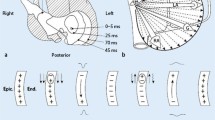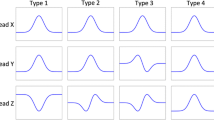Abstract
P-wave represents the atrial depolarization, and the analysis of the P-wave morphology is an important element of the ECG interpretation. P-wave’s most frequent alterations are secondary to left atrial, right atrial, or biatrial enlargement.
Left atrial enlargements cause a prolonged and increased amplitude of the P-wave terminal part. Right atrial enlargement instead causes an increased amplitude of the initial P-wave part with taller and peaked but not prolonged P-waves. In case of biatrial enlargement, the criteria for both right and left atrial enlargements must be satisfied.
Atrial activations may also come from foci other than sinus node. In this case the P shape analysis is crucial to identify the specific site of origin of the ectopic atrial excitation.
In this chapter, we report on few clinical cases that show how the morphology analysis of the P-wave could give us important clues to better clinically evaluate the patients.
Access this chapter
Tax calculation will be finalised at checkout
Purchases are for personal use only
Similar content being viewed by others
References
Bogossian H, Frommeyer G, Ninios I, et al. New formula for evaluation of the QT interval in patients with left bundle branch block. Heart Rhythm. 2014;11:2273–7.
Frommeyer G, Bogossian H, Pechlivanidou E, et al. Applicability of a novel formula (Bogossian formula) for evaluation of the QT-interval in heart failure and left bundle branch block due to right ventricular pacing. Pacing Clin Electrophysiol. 2017;40(4):409–16.
Surawicz B, Knilans T. Chou’s electrocardiography in clinical practice. 6th ed. Philadelphia: Saunders Elsevier; 2008. p. 22–44.
Zipes DP, Libby P, Bonow RO, Braunwald E. Braunwald’s heart disease: a textbook of cardiovascular medicine. 10th ed. Philadelphia: Elsevier; 2014. p. 125–7.
Oreto G. L’elettrocardiogramma: un mosaico a 12 tessere. Mila: Edi-ermes; 2008. p. 39–46.
Harrigan RA, Jones K. ABC of clinical electrocardiography. Conditions affecting the right side of the heart. BMJ. 2002;324(7347):1201–4.
Bagliani G, Leonelli F, Padeletti L, et al. P wave and the substrates of arrhythmias originating in the atria. Card Electrophysiol Clin. 2017;9(3):365–82.
Author information
Authors and Affiliations
Editor information
Editors and Affiliations
Rights and permissions
Copyright information
© 2019 Springer Nature Switzerland AG
About this chapter
Cite this chapter
Cupido, C., Enea, G., Menditto, A., Pierandrei, C. (2019). Atrial Pathologies. In: Capucci, A. (eds) New Concepts in ECG Interpretation. Springer, Cham. https://doi.org/10.1007/978-3-319-91677-4_2
Download citation
DOI: https://doi.org/10.1007/978-3-319-91677-4_2
Published:
Publisher Name: Springer, Cham
Print ISBN: 978-3-319-91676-7
Online ISBN: 978-3-319-91677-4
eBook Packages: MedicineMedicine (R0)




